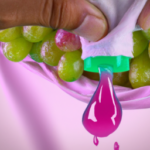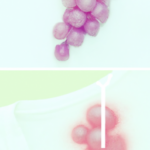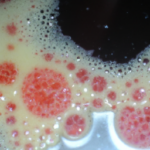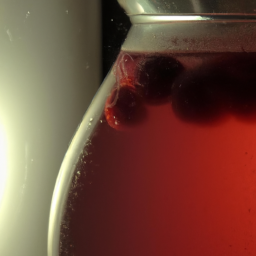I absolutely love pomegranate juice, but I hate it when it spills on my clothes. The rich red color is stubborn and difficult to get out, especially if it sits for a while. Thankfully, I have found some ways to remove pomegranate juice stains from clothing and I’m excited to share these tips with you.
The first step is to identify the stain type and fabric type. Is the fabric synthetic or natural? Is it delicate or sturdy? Is the stain fresh or old? These factors will determine the best approach to remove the stain without damaging the fabric.
Once you know what you’re dealing with, you can follow the steps I’ll outline in this article to effectively remove the stain and restore your clothes to their former glory.
Key Takeaways
- Blot the stain with a clean cloth immediately and rinse with cold water to remove excess juice.
- Soak the stained fabric in water and detergent for several hours, agitating every 30 minutes.
- Wash the fabric with cold water, vinegar, and baking soda, and avoid hot water, bleach, and fabric softener.
- Air dry the fabric and use low heat when ironing, and take preventative measures when eating fruits likely to stain clothes.
Identify the Stain Type and Fabric Type
Alright, let’s figure out what kind of stubborn pomegranate stain we’re dealing with and what fabric it’s on.
The first step in getting rid of any stain is to identify the fabric type and the type of stain. Different fabrics require different treatments, and certain stains require specific stain removal solutions.
When it comes to identifying fabric types, you need to look at the care label on your clothing. The label should tell you the type of fabric and provide specific washing instructions. Knowing your fabric type will help you determine the best course of action for removing the stain without damaging the fabric.
As for understanding stain removal solutions, you need to know that pomegranate juice is a tough stain to remove. It’s important to act quickly and use the right solution for your fabric type to prevent the stain from setting in.
Now that we’ve identified the fabric type and the type of stain, it’s time to move on to the next step – blotting the stain with a clean cloth.
Blot the Stain with a Clean Cloth
As I gently dab at the vibrant red mark on my garment with a soft cloth, I begin to realize the importance of preventing stains and taking care of the little marks in my life before they become bigger problems.
One way to prevent fruit juice stains is by wearing an apron or old clothing while preparing or eating fruits like pomegranates. However, in case of any stains, it’s important to act fast and blot the stain with a clean cloth immediately.
It’s also important to note that different fruit juice stains may require different approaches for removal. For example, while pomegranate juice stains can be removed by blotting, removing other fruit juice stains may require the use of a specific stain remover. Therefore, it’s important to identify the type of stain and fabric type before attempting any removal methods.
With that said, the next step after blotting the pomegranate juice stain is to rinse the stain with cold water.
Rinse the Stain with Cold Water
After gently blotting the red mark on my favorite shirt, I rush to the sink and rinse the stain with cold water, hoping to save my beloved garment from permanent damage.
I know that preventing stains is always better than removing them and that’s why I always try to be extra careful while eating or drinking anything that can potentially leave a mark. However, accidents happen, and that’s why it’s important to know the right way to deal with them.
Rinsing the stain with cold water helps to remove any excess pomegranate juice from the fabric. This step is crucial as it prevents the stain from setting in and becoming permanent.
After rinsing the stain, I check to see if it has completely disappeared. If not, I don’t panic and instead proceed to soak the stain in a mixture of water and the right detergent, as recommended by the manufacturer.
Soak the Stain
To properly tackle the pomegranate stain, you’ll need to fill a bowl with cold water and a generous amount of detergent.
As you soak the stained fabric, take a deep breath and remind yourself that this is just a minor setback.
Here are a few things to keep in mind during this step:
- Be patient: Depending on the severity of the stain, you may need to soak the fabric for several hours or even overnight. Don’t rush the process or you risk setting the stain even further.
- Agitate the water: Every 30 minutes or so, give the fabric a gentle stir or swish to help loosen the stain from the fibers.
- Prevent future stains: While the fabric is soaking, take a minute to consider how you can avoid similar stains in the future. Perhaps you’ll decide to wear an apron while cooking, or maybe you’ll take extra care to avoid eating messy foods near your clothing.
Once you’ve let the fabric soak for the appropriate timeframe, it’s time to move on to the next step: washing the fabric.
Wash the Fabric
Now it’s time to throw the soaked fabric into the washing machine with a cup of vinegar and a scoop of baking soda to ensure that the stain is completely removed and future stains are prevented. Vinegar helps to break down the pomegranate juice stain while baking soda helps to absorb any remaining residue.
It’s important to use cold water since hot water can set the stain into the fabric permanently. To prevent staining accidents in the future, it’s important to be cautious when consuming pomegranate juice and to immediately address any spills or splatters.
It’s also important to follow fabric care tips, such as reading the label instructions before washing and avoiding using bleach or fabric softener on stained clothing. With these precautions and proper care, your clothes can remain stain-free and in good condition for longer.
As you take the fabric out of the washing machine, it’s important to check the stain to ensure that it has been completely removed before drying.
Check the Stain
Before tossing the fabric in the dryer, it’s important to make sure the stain is completely gone, so you don’t end up crying over spilled milk.
Pomegranate stains can be stubborn and difficult to remove, especially if they are allowed to set in. Common causes of pomegranate stains on clothes include eating the fruit, spilling juice, or accidentally rubbing against a pomegranate tree.
To prevent pomegranate stains on clothes, always wear an apron or protective clothing when handling the fruit. Additionally, try to eat pomegranates over a plate or bowl to catch any stray juice.
When it comes to removing pomegranate stains from clothes, the right laundry detergent can make all the difference. Look for a detergent that is specifically designed to remove fruit stains from fabrics. Some of the best laundry detergents for removing fruit stains from fabrics include OxiClean, Tide, and Persil. These detergents are formulated to break down the pigments in pomegranate juice and lift them from the fabric.
To treat lingering stains, try using a stain remover or soaking the fabric in a mixture of vinegar and water before washing. With a little bit of patience and persistence, you can get rid of even the most stubborn pomegranate stains from your clothes.
Treat Lingering Stains
When dealing with lingering stains on clothes, I’ve found that using vinegar or lemon juice can be effective. Simply mix equal parts of either ingredient with water and soak the stained area for a few hours before washing as usual.
Another solution is to use hydrogen peroxide, which can be applied directly to the stain and left for a few minutes before washing. These methods have worked for me in the past and have saved many clothes from being ruined by stubborn stains.
Use Vinegar or Lemon Juice
Using vinegar or lemon juice is an effective way to get pomegranate juice stains out of clothes. If you’re someone who drinks pomegranate juice often, you know how easily it can leave behind a stain. But, don’t worry, using vinegar or lemon juice can help you get rid of those pesky stains.
Vinegar is a versatile ingredient that can be used in different ways at home. It’s not only great for cooking, but it’s also an effective cleaning agent. The acidic nature of vinegar makes it an excellent stain remover. To use vinegar or lemon juice to remove pomegranate juice stains from clothes, simply pour some vinegar or lemon juice onto the affected area. Let it sit for a few minutes before rinsing it off with cold water. You can also add some baking soda to the vinegar or lemon juice for a more effective stain removal.
After rinsing the stain, you can wash the clothes as usual. If vinegar or lemon juice doesn’t work, don’t worry, there are other ways to get rid of pomegranate juice stains. One effective method is to use hydrogen peroxide. But, we’ll talk about that in the next section.
Use Hydrogen Peroxide
I’ve tried using vinegar and lemon juice to remove pomegranate juice stains from my clothes, but sometimes those methods just don’t cut it. That’s when I turn to an alternative method: hydrogen peroxide.
Here are the steps I follow when using hydrogen peroxide to remove pomegranate juice stains:
- First, I pour a small amount of hydrogen peroxide directly onto the stain.
- Then, I use a clean cloth or sponge to gently blot the stain, being careful not to spread it around.
- After blotting, I let the hydrogen peroxide sit on the stain for a few minutes.
- Finally, I rinse the fabric with cool water and wash it as usual.
It’s important to note that hydrogen peroxide can be harsh on some fabrics, so it’s important to do a spot test first and to use caution when using this method. Safety precautions should always be taken when handling any cleaning solutions.
Now that we’ve tackled the issue of removing the pomegranate juice stain, the next step is to air dry the fabric to prevent any further damage.
Air Dry the Fabric
Now, just hang up the clothes and let them dry naturally in the air. Air drying is a great way to get pomegranate juice out of clothes without causing any further damage to the fabric. Not only is it a cost-effective method, but it also has many benefits for your clothes.
Air drying can help prevent fabric shrinkage, which is a common problem when using a dryer. It also helps to preserve the fabric’s color and texture, making your clothes last longer. To prevent shrinkage, make sure to reshape the clothes while they are still damp and avoid hanging them in direct sunlight or heat. With these tips, air drying can become a regular part of your laundry routine.
As the clothes dry, you may notice that there is still a visible stain from the pomegranate juice. In the next section, I will explain how to iron the fabric to remove any remaining stains.
Iron the Fabric
When ironing the fabric to remove pomegranate juice stains, it’s important to use a low heat setting. This will prevent any further damage to the fabric and ensure that the stain is removed effectively.
Additionally, it’s recommended to use a pressing cloth to protect the fabric from direct heat and prevent any potential scorching.
Use a Low Heat Setting
Start by setting your dryer to a low heat setting to avoid setting the pomegranate juice stain into the fabric. This is especially important if you’ve already ironed the stained area, as heat can set the stain further into the fabric. If you don’t have a low heat setting on your dryer, consider air-drying the garment instead.
When using a low heat setting, it’s important to be patient. It may take longer for the garment to dry, but it’s worth it to avoid damaging the fabric. Once the garment is dry, check to see if the stain is still visible. If it is, repeat the previous steps of applying detergent and washing the garment.
To further protect the fabric, use a pressing cloth in the next step. This will prevent any further damage to the fabric while you work on removing the stain.
Use a Pressing Cloth
Using a pressing cloth is like putting a shield over your garment while removing the stubborn stain, allowing you to clean without causing any further harm to the fabric. The benefits of using a pressing cloth are plentiful.
First and foremost, it protects your clothing from the high heat of the iron. Secondly, it provides a barrier between the iron and the stain, preventing the stain from spreading or setting in further. Thirdly, it helps to evenly distribute the heat, ensuring that the fabric is not damaged or scorched.
There are different types of pressing cloths to use, depending on the fabric and the type of stain. A muslin cloth is a common choice, as it is lightweight and allows for easy steam penetration. A terry cloth is a good option for heavier fabrics, as it can absorb excess moisture and provide extra cushioning. Silk organza is another option, and is especially useful for delicate fabrics such as silk or satin.
Regardless of the type of pressing cloth used, be sure to choose one that’s clean and free of any stains or debris.
Transitioning into the subsequent section about ‘repeat the process if needed’, it’s important to note that sometimes one application of the pressing cloth may not be enough to completely remove the pomegranate juice stain. In that case, don’t be discouraged – simply repeat the process until the stain’s gone to your satisfaction.
Repeat the Process if Needed
If the stain isn’t fully removed, don’t give up yet – give it another go! Sometimes, pomegranate juice stains can be stubborn and require multiple attempts to remove entirely. But don’t worry; with a few simple steps, your clothes can look as good as new.
To repeat the process:
- Saturate the stained area with cold water.
- Apply a stain remover or laundry detergent directly to the stain and let it sit for a few minutes.
- Gently rub the fabric together to work the solution into the fibers.
- Rinse the garment thoroughly with cold water and inspect the stain.
- If it’s still visible, repeat the process until the stain is gone.
Remember to always test the stain remover on a small, inconspicuous area of the garment before applying it to the stain. By following these steps and having a bit of patience, you’ll be able to remove even the toughest pomegranate juice stains from your clothes.
And as a bonus tip, remember to take preventative measures when eating fruits that are likely to stain clothes, such as wearing an apron or bib, and removing any spills immediately to avoid further damage.
Frequently Asked Questions
Can I use warm or hot water instead of cold water to rinse the stain?
I recommend using warm water for stain removal. However, before rinsing, I would pre-treat the stain with a mixture of vinegar and baking soda for optimal results. This method has proven effective in removing tough stains.
What type of soap or detergent should I use to wash the fabric?
When it comes to washing fabric, I always use the best fabric detergents. For tough stains like pomegranate juice, pre treating methods are crucial. Look for a detergent with enzymes to break down the stain and follow the instructions carefully for best results.
Will the pomegranate stain come out completely or will there still be some discoloration?
I’ve found that removing pomegranate stains from clothing can be tricky, but with proper treatment, it’s possible for the stain to come out completely. Preventing future stains involves quick action and using stain-removing products designed for different types of fabrics.
Can I use a dryer to dry the fabric instead of air drying it?
I wouldn’t recommend using a dryer to dry stained fabric as the heat can set the stain. It’s best to air dry first, then treat the stain with a stain remover before washing. Proper fabric care is important to remove stains effectively.
Will the ironing process damage the fabric or leave any marks on it?
Ironing safety is crucial to avoid damaging the fabric or leaving marks. There are alternative stain removal methods to consider, such as using vinegar or lemon juice. Always test a small area first and follow care instructions.
Conclusion
Well, that was a messy situation, but don’t worry, I’ve got you covered on how to get pomegranate juice out of clothes.
First things first, identify the stain type and fabric type to ensure you use the right method. Blot the stain with a clean cloth to remove excess juice, then rinse with cold water.
Soak the stain in a mixture of water and laundry detergent for 30 minutes before washing the fabric in the washing machine. If there are still lingering stains, treat them with a stain remover or white vinegar before air drying the fabric.
Once dry, iron the fabric to ensure a smooth finish. And if the stain is still there, don’t give up! Repeat the process as many times as needed until the stain is completely removed.
Remember, accidents happen and it’s important to stay calm and tackle the problem head-on. As the saying goes, "where there’s a will, there’s a way."And with these steps, you’ll have that pomegranate juice stain out in no time.
Happy cleaning!
Ilana has been a vegan for over 10 years. She originally made the switch for health reasons, but soon found herself becoming more and more passionate about the ethical and environmental implications of a vegan lifestyle. Ilana is the author of The Graceful Kitchen, a blog all about veganism. She loves to cook up delicious and nutritious vegan meals, and share her recipes with others who are interested in leading a cruelty-free life. Ilana is also a strong advocate for using whole foods as the foundation of a healthy diet, and believes that going vegan is one of the best ways to achieve this.
















